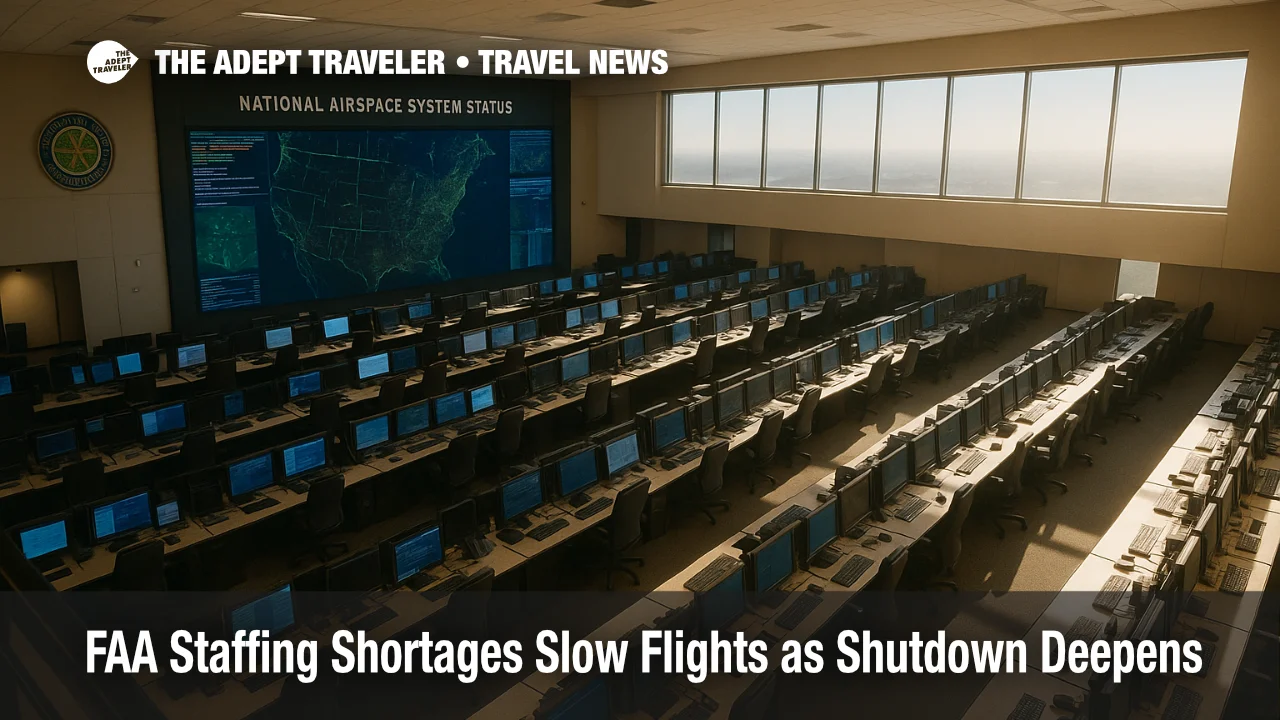FAA staffing shortages slow flights as shutdown deepens

Air traffic control staffing has become the defining constraint on U.S. flight operations as the government shutdown enters its second week. The FAA says it is deliberately slowing traffic into select airports to preserve safety, while Command Center advisories show "staffing triggers" behind several ground-delay programs this week. Transportation officials and union leaders confirm controllers are working without pay on extended schedules, and some facilities have posted thin coverage windows that ripple into departure banks. Expect targeted delays on October 9, 2025, especially during morning and evening peaks.
Key points
- Why it matters: Safety-driven rate cuts shift delays from the air to the gate.
- Travel impact: Targeted ground-delay programs and holds at major hubs during peaks.
- What's next: Slower arrival rates are likely until appropriations resume or staffing stabilizes.
- FAA confirms it will "slow traffic" when staffing dips to ensure safe operations.
- ATCSCC advisories list staffing triggers for multiple facilities this week.
Snapshot
The FAA's Air Traffic Control System Command Center (ATCSCC) advisories for October 6-9 cite staffing triggers that prompted ground-delay programs and rate reductions at several airports. Examples include Nashville International Airport (BNA) and Boston Logan International Airport (BOS), with additional constraints noted for New York airspace and Philadelphia sectors. The National Airspace System Status dashboard continues to show intermittent metering into high-demand hubs when facility coverage thins. Separately, Transportation Department contingency plans confirm 13,000-plus controllers are "excepted" and working without pay. Reuters and other outlets report a surge in staffing-attributed delays during the shutdown, with facilities posting extended shifts to maintain coverage. Travelers should build extra time and monitor EDCTs for any flight bound to constrained airports.
Background
During a lapse in appropriations, core air traffic services continue, but supporting functions scale back. The U.S. Department of Transportation's shutdown plan keeps air traffic control operating, including controller hiring and field training, while many non-safety activities pause. The FAA states that when staffing runs thin at a tower, TRACON, or center, it will "slow traffic into some airports to ensure safe operations." ATCSCC translates that into operational initiatives like ground-delay programs that meter arrivals via EDCTs. For context on how these programs unfold across a day's push, see our explainer, How a tower staffing gap at Burbank ripples across the network.
Latest developments
FAA staffing triggers drive targeted delay programs today
ATCSCC Operations Plan advisories issued October 6-8 referenced staffing triggers for facilities covering Boston Logan International Airport (BOS), Nashville International Airport (BNA), Philadelphia sectors, and others, with at least one BNA ground-delay program specifically "due to a staffing trigger." FAA's general statement on October 6 reiterated that when staffing shortages occur, the agency reduces rates into affected airports to keep operations safe. Live NAS status this morning shows continued metering potential for peak periods. Public and union reports indicate controllers are working extended shifts without pay during the shutdown, and federal data show more facilities flagged for low staffing than in recent years. Expect rolling gate holds and EDCTs into hubs such as Reagan Washington National Airport (DCA), Newark Liberty International Airport (EWR), Chicago O'Hare International Airport (ORD), Denver International Airport (DEN), Miami International Airport (MIA), Fort Lauderdale-Hollywood International Airport (FLL), San Francisco International Airport (SFO), Seattle-Tacoma International Airport (SEA), and Hollywood Burbank Airport (BUR) if local coverage dips.
Where to watch for knock-on effects
Lean windows at one facility can cascade across banks and connections, especially in the Northeast and Mid-Atlantic flows. Oceanic and East Coast route adjustments tied to New York sectors can push reroutes and longer block times into evening peaks. When demand still exceeds a reduced arrival rate, Command Center turns to collaborative ground-delay programs with controlled pushbacks at origin airports. Yesterday's plan listed staffing triggers after 11:00 a.m. for Philadelphia airspace, while earlier this week BOS ran a construction-compounded GDP through the evening. For a day-by-day preview of likely hot spots, see FAA staffing and shutdown: Rolling delay programs likely.
Analysis
The near-term travel story is not blanket cancellations but precision slowdowns. FAA's approach "buys safety with time," trading speed for predictability by cutting acceptance rates at pressure points. Because controllers are excepted employees working without pay, coverage is maintained but thinner than ideal, and the system becomes less resilient to ordinary friction like low ceilings, runway work, or convective weather. That is why you see concentrated ground-delay programs during BOS runway constraints and BNA staffing windows, and why DCA or EWR can show brief metering tied to New York and Philadelphia sectors.
For travelers, the practical moves are to pad connections at BOS, EWR, DCA, ORD, DEN, SFO, SEA, MIA, FLL, and BNA today; watch for EDCTs on departures bound for constrained hubs; and rebook early if a misconnect looms. For airlines and airports, keeping turn times crisp and pro-actively reflowing passengers matters more on days when ATC rates dip. Systemwide reliability should improve quickly once appropriations restore pay and scheduling stability, but until then, expect a conservative rate posture at peak times driven by FAA staffing shortages.
Final thoughts
Plan for targeted delays and controlled pushbacks rather than wholesale cancellations. The FAA will continue to meter arrivals when staffing dips to keep the system safe, with the biggest friction on peak banks into Northeast and hub airports. Build buffer time, watch your EDCT, and expect a slower but steadier flow while the shutdown persists. Until funding resumes, the most important phrase in U.S. air travel is "FAA staffing shortages."
Sources
- FAA General Statements: FAA statement on air traffic controller staffing, FAA
- ATCSCC Advisory: Operations Plan, staffing triggers and GDPs (Oct 6-8), FAA
- ATCSCC Advisory: BNA ground-delay program due to staffing trigger, FAA
- NAS Status: National Airspace System live dashboard, FAA
- DOT lapse plan: Excepted air traffic services and staffing levels, U.S. DOT
- NATCA statement: Controllers working without pay; mandatory overtime, NATCA
- Reuters: FAA delays flights; facilities flagged for low staffing, Reuters
